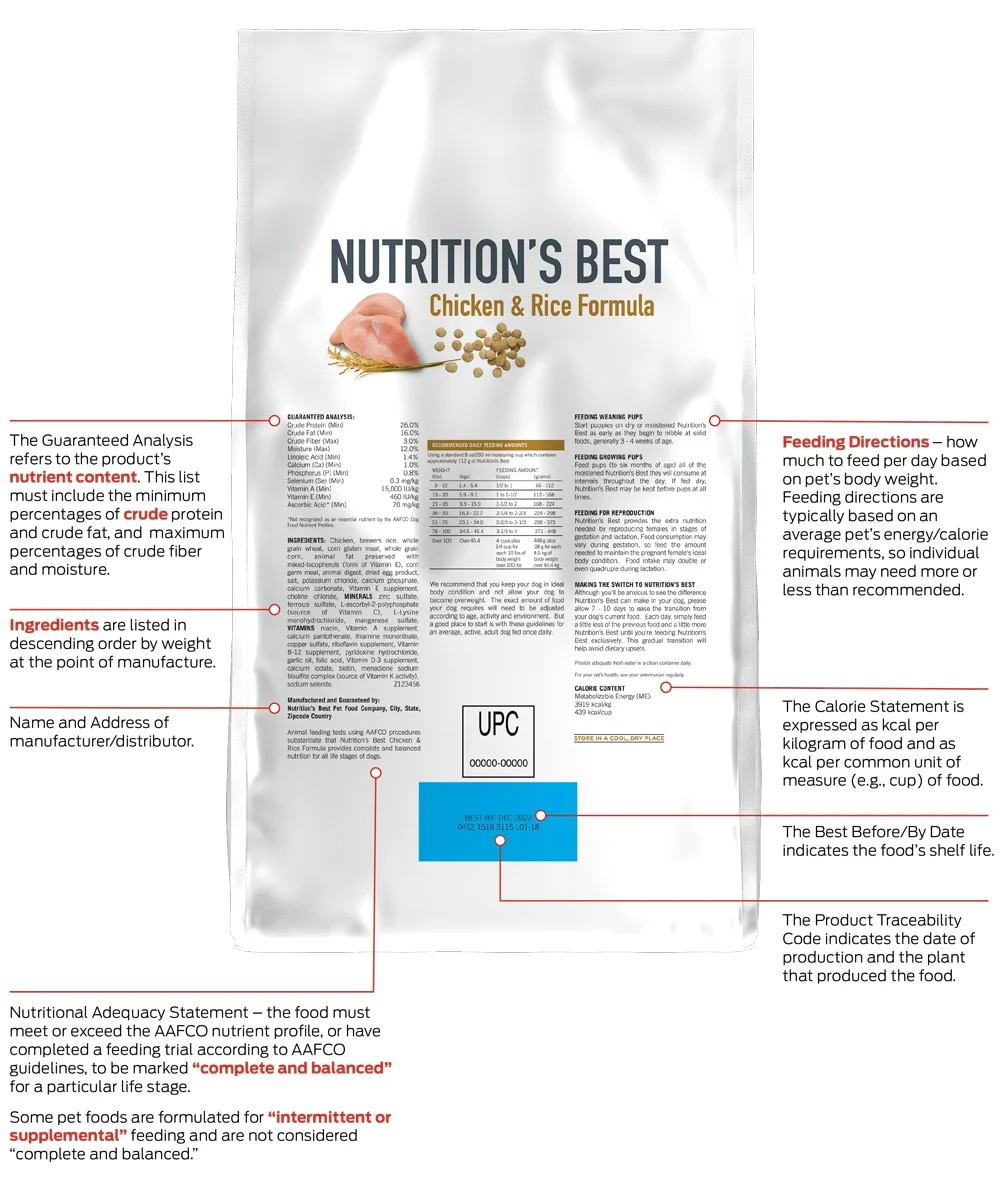
Understanding Pet Food
Understanding Pet Food Labels - AAFCO
Pet food labels contain a lot of information including details that are required by federal and state regulations as well as information specific to the product, e.g., claims. Although the Association of American Feed Control Officials (AAFCO) has no regulatory authority, it is made up of representatives from governmental agencies in the US, Canada, Costa Rica, and Puerto Rico that do regulate pet food and other animal feed. AAFCO provides guidance to the agencies with its Model Pet Food Regulations, which many states have incorporated into their own state regulations. According to the AAFCO Model Pet Food Regulations, pet food labels should contain the information below.
Note: The location of the information on pack can vary.


Further Information on Terminology:
- The Product Descriptor may include the name of an ingredient or flavor under these AAFCO-defined circumstances:
- "100%," e.g., "100% Beef,” indicates that the named ingredient comprises 100% of the product (excluding water or trace amounts of preservatives or other supplemental ingredients). These products would typically be treats or “toppers,” since they do not provide complete and balanced nutrition.
- "95%," e.g., "95% Beef Dog Food” or "95% Salmon and Chicken Cat Food," indicates that 95% of the food by weight (excluding water, and 70% including water) is comprised of the named ingredient or combination of ingredients. If the name includes a combination of ingredients, each ingredient must comprise at least 3%, and the ingredients should be listed in the name in descending order. These products can provide complete and balanced nutrition.
- "Dinner," "platter," "entrée," "formula," and "recipe," e.g., "Chicken & Rice Formula," indicate that the named ingredients together comprise at least 25% (excluding water, and 10% including water) and each comprise at least 3% of the food by weight (excluding water). The manufacturer can choose to list none, some, or all of the ingredients that meet these requirements as part of the name.
- "With," e.g., "with Sweet Potato," indicates that the named ingredient comprises at least 3% of the food by weight (excluding water).
- "Flavor," e.g., "Chicken Flavor," indicates that the named ingredient must be present only in the amount needed to impart flavor.
- nutrient content – additional nutrients may be listed after moisture in the Guaranteed Analysis. If a claim on the package includes a nutrient, e.g., "DHA for brain and vision development," that nutrient must be included in the guaranteed analysis as a minimum. The guaranteed analysis statement, which is based on minimums or maximums, will differ from a "typical" or "average" nutrient analysis, which may be included in brand/product literature or on the manufacturer/brand website and which is based on averages.
- Crude refers to the assay (the analytical method) used to determine the amount of the nutrient. It does not refer to or reflect the quality of the ingredients used.
- All Ingredients must be listed individually by their AAFCO-defined names. If an ingredient does not have an AAFCO-defined name and definition, its common or usual name should be used. Brand names are not permitted. The species for any meat or meat byproducts, other than cattle, swine, sheep, or goats, must be named. Although not required, cattle, swine, sheep, or goats may be named, if desired, by the manufacturer. Indications of ingredient quality are not permitted. Font style, size, and color should be consistent for all ingredients so as not to emphasize any individual ingredients.
- The Feeding Directions are guidelines. Every pet is an individual, and many factors, such as activity level, age, breed, environment and genetics, can affect the amount of calories a pet needs. The pet’s body condition should be monitored regularly, and the amount of food adjusted to maintain ideal body condition.
- "Complete and balanced" indicates that the food provides all of the nutrients needed in the correct amounts and ratios relative to one another. The Nutritional Adequacy Statement will use one of three formats, all specifying the name of the product and the life stage (growth [puppy or kitten]/reproduction, adult maintenance, or all life stages) for which the food provides complete and balanced nutrition:
- "Formulated to meet" confirms an analysis has shown the food meets the nutrient profile standard.
- An "animal feeding test" claim means the food was fed to dogs or cats according to AAFCO’s feeding protocols.
- The "family products claim" may be used for a food in the same "family" as another product that has been substantiated by an animal feeding test. The food may have a slightly different formulation but cannot differ on a nutritional basis.
- Foods classified for "intermittent or supplemental" feeding are typically broths or "toppers," but may include some wet foods. These foods do not provide complete and balanced nutrition and are intended as a complement to be fed with a complete and balanced diet. Some veterinary therapeutic diets are labeled for “intermittent or supplemental” feeding because they are restricted in certain nutrients in order to provide support for the disease(s) for which they are labeled and do not provide complete and balanced nutrition to normal, healthy animals. These are intended to be fed only under the direction of a veterinarian.
To Share With Pet Owner:
Feeding Guidelines on Pet Food Labels
Feeding guidelines are designed to help owners determine the quantity of food to feed their pets to ensure an optimal body condition, but owners may be unsure how to use them.